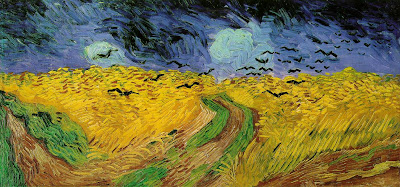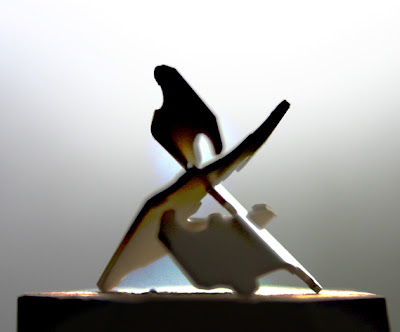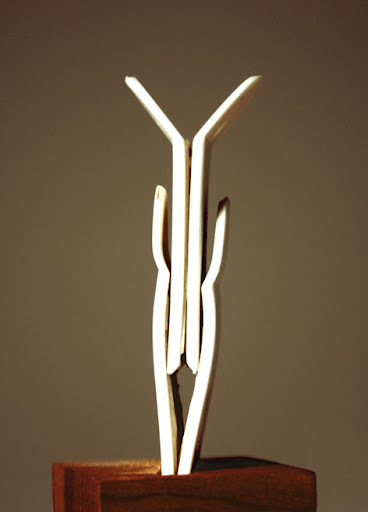one cannot expect to raise appreciation of one's art without taking some trouble to at least show it to one other person. in the most fortuituous case, this might start a snowballing effect, and the end of the year sees thousands of artistic pilgrims coming to your studio, begging for an artwork, any artwork, as long as it carries your signature... :-)
in reality, art appreciation usually works a little differently. i've had many individual art lovers be enthusiastic about my work, but i hardly sell enough. in order to make a living i should have much better access to people who are really looking for art to buy. and then, as with so much other endeavours in life, competition and all sorts of extraneous parameters come in. in the contemporary art world, the valuation and apppreciation is often most difficult, even for experts. there is a lot of hot air...extremely so even.
let's just take two quotes from germaine greer on damien hirst (she comments on robert hughes' criticism of damien hirst, in the guardian 2008)
What is touching about Hughes's despair is that he thinks that artists still make things. It's a long time since Hirst actually made an artwork with his own hands.
...
Hirst is quite frank about what he doesn't do. He doesn't paint his triumphantly vacuous spot paintings - the best spot paintings by Damien Hirst are those painted by Rachel Howard. His undeniable genius consists in getting people to buy them. Damien Hirst is a brand, because the art form of the 21st century is marketing. To develop so strong a brand on so conspicuously threadbare a rationale is hugely creative - revolutionary even.
damien hirst is the well-known extreme example of how contemporary art is more about marketing than about the art itself. but these mechanisms also impact on a small-time (at least economically speaking :-)) artist like myself. so, according to the experts, what should you do if you want to succeed as an artist - which is always interpreted in terms of selling your art, by the way-? the gist of it, as i perceive it, is as follows:
- be recognizable: do something different, but don't change this: your own style
- work on a branding strategy: brand yourself as an artist, brand your art (your own style)
- work on your cv by participating in many events, show your art in many places, according to your branding strategy and pricing strategy, get your name noticed
- network, and use your networks, look for endorsements from `art experts'
- use all social media to draw attention to you and your work
some of this stuff is new (sometimes in its extreme form only), but other aspects already plagued artists in medieval times i think. strikingly, together with marketing dominating art, as a logical consequence of postmodern value confusion, (acclaimwise) successful contemporary art has officially lost connection with aesthetics. this actually leads to a shadow world: the world of `stuffy' traditional visual art values, in which `small-time' artists like myself operate.
another quote for you, from a very nice review of the book: seven days in the art world (review by adrien favell, book by sarah thornton).
It is perhaps this socially mobile dynamic in the book, that accounts for the fact that Thornton mostly dwells on success and fame in the art world, not its obverse—despite, in fact, the truth that this world is driven not by the stars who made it, but the also rans, in vast numbers, who get smashed trying. Only once do we get a glimpse of this other side of art: in a light and sensitive portrait of a day amongst slacker students at a California art school. The lockjaw of theory and conceptualism on contemporary art is graphically illustrated in the scorn these struggling and mostly hopeless young artists pour on notions that art has anything to do with “beauty” or “affect”. Everyone in the art world today talks this talk today, but it has to be noted how much a role these desperately old fashioned notions still play in motivating the big auction sales—something well observed by Don Thompson. But apart from the students, Thornton has much less to say about the lives and work of the legions of those who are always hopefully (or euphemistically) referred to “emerging” artists, trying to make the leap across the chasm from art school to Turner prize nomination. The book analyses the anxieties of the Turner prize nominees, but these are already “successful” artists; the everyday action in the art system is generally going on well below this, at a more intermediate level, in the mundane actions of dealers and artists to scratch out a career and living against its brute statistics of failure.
please read the review, you will notice that its author has far more stamina in writing about these things than i do. some people write really well, to the enjoyment of many. i hope that my writing, impatient as it may be, still contributes something too...since there are so few artists entering the fray of writing about art. i commented on this earlier, it is a bit comparable to having the discipline of complex surgery being dominated by non-surgeons.






